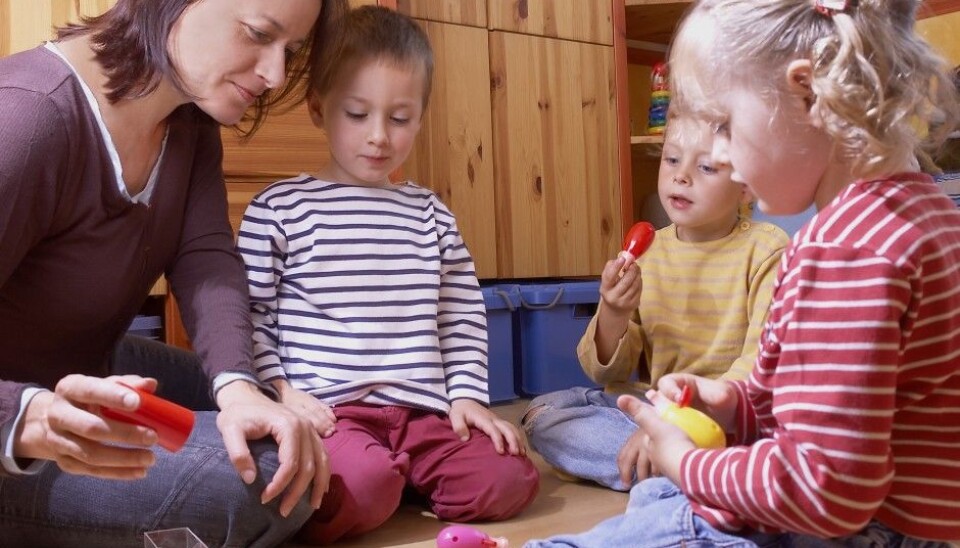
Open day care centres fill vital role
The number of open day care centres in Norway is dropping, despite the help they give to troubled families.
Denne artikkelen er over ti år gammel og kan inneholde utdatert informasjon.
A new study shows that open day care centres can be good for parents who don’t speak Norwegian well, or who are jobless or on disability benefits.
Open for one and all
Norway has about 200 so-called open day care centres.
They are what they sound like ― open. A child does not need a formal, enrolled place in a kindergarten or day nursery. The centres are open to anyone who has the time, the desire or the need. Another difference from regular kindergartens, which are formally called Early Childhood Educational and Care Institutions (ECECs), is that a parent or guardian has to be on site along with the child.
Otherwise they are like most kindergartens. They have daily get-togethers where all the kids and staff interact, and engage the kids in usual activities like arts and crafts, singing and eating together.
“The idea is to provide something enjoyable and meaningful for the children as well as the adults,” says researcher and project manager Kjell-Åge Gotvassli.
He and Anne Sigrid Haugset of the Trøndelag R&D Institute visited six open day care centres and interviewed employees and 36 users of this pre-school system.
They also sent questionnaires to all the leaders of the 200 open day cares in Norway.
Breaking out of isolation
The researchers found considerable diversity among the users of open day care facilities. This arrangement appeared to be of great support and help to parents who spoke little Norwegian, who were unemployed or on disability.
“If they don’t speak Norwegian, lack an education or are physically or mentally ill, getting a foothold in the Norwegian job market can be pretty tough. The result can be loneliness and social isolation,” points out Haugset.
“This is where an open day care can be a real advantage and a good place to be with the kids,” she says.
A healthy mix
It’s important that attendance isn’t limited to people with special challenges. This is not a offering that is limited to those who are most needy and are struggling.
“You cannot soley have needy or vulnerable families in a kindergarten,” says Haugset.
“In order for the open day care to include all sorts, it has to appeal to a wide array of parents with young children. They can be parents on leave from work who plan to enrol their kids and secure a place in ECECs, or those who decide not to for one reason or another," she says.
Closing them down
One of the main reasons why the open day care centres were started in the 1980s was that municipalities couldn’t keep up with demand for full ECEC coverage.
Now that every child in Norway has a legal right to place in an ECEC and capacity is generally up to par, several municipalities are closing down their open day care institutions, simply because they think these are no longer needed.
Local politicians in Bergen decided to slash allocations to the city’s open day care centres. This caused a lot of protests and demonstrations earlier this year by staff, parents and the children who attend them.
In Oslo several of the open day care centres have also been shut down.
It has been difficult to accurately gauge the demand and number of users because the centres are so open. Some of them register all the kids and parents who come each day, some make lists for each week and some simply tally all the users in the course of a year. There are also open day care centres that refrain from making such lists, except a roster required for safety and controls in case of a fire, and these are shredded at the end of the day.
This makes it hard for researchers to say exactly how many users these day cares have and how many really want to use them.
Often resourceful
The most ardent users of the open day cares are not the needy families with special challenges. While the researchers did visit some of these kindergartens where families with problems were in the majority, there were others where troubled families were not found at all.
“These [challenged] users comprise just a small share and they were not present in all the open day care centres,” says Haugset.
“But the importance for each individual child and family can be quite considerable.”
Starting in ordinary kindergartens
One of the major criticisms of the open day cares is simply that parents can choose them instead of the ordinary ECECs. As a result, children with immigrant backgrounds might attend these infrequently and be less prepared to start elementary school in first grade as six-year-olds. In addition, because parents have to be on the premises, the centres may actually act as obstacles keeping parents from getting jobs.
But the new study shows that most of the children in the open day cares transfer over to ECECs after a while.
Half of the employees answered that they had told parents about ECECs and helped them fill out applications for their kids. Many also supplied users with lists of the regular kindergartens and available places in them.
Thus the researchers in Trøndelag County think the open day care centres can serve as an important recruiting service to bring children to ordinary kindergartens.
Morten Bakke, a political adviser to the Oslo City Council, agrees.
“In several of Oslo’s 15 municipal districts the open day care centres play key roles in recruiting children of immigrant families to kindergartens. This is a fine way for them to get acquainted with kindergartens and what these offer. They can also get help applying for a place in a regular kindergarten,” he says.
------------
Read the Norwegian version of this article at forskning.no
Translated by: Glenn Ostling






























